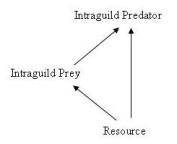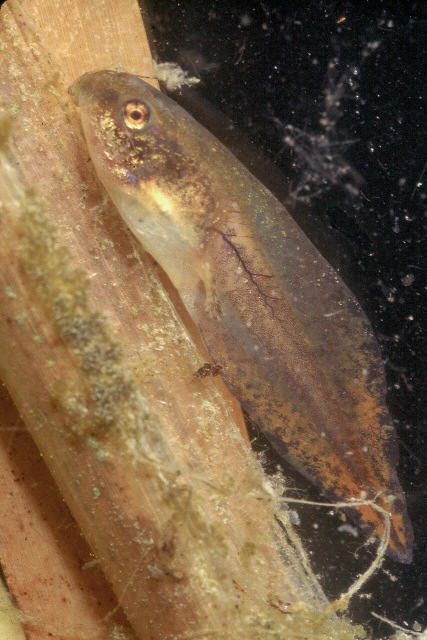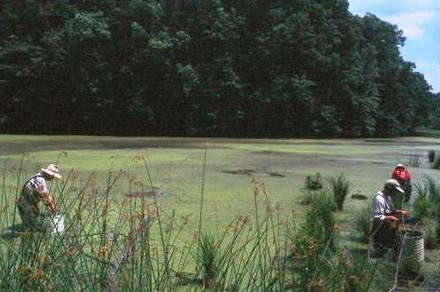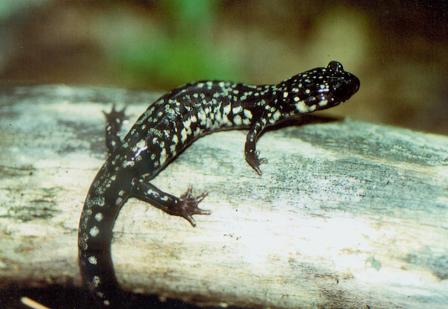Research interests
Below are brief descriptions of some of my more specific research interests.
Intraguild predation
 In
many communities, members of one species (the intraguild predator) can
both prey upon and compete with members of a second species (the
intraguild prey). In
nature these interactions are common in a wide range of taxa, and they
offer a unique opportunity to examine how competition and predation
interact to influence species coexistence and community structure. A
key question is how intraguild prey persist in the face of both
competitive and predatory pressure from their intraguild predators.
Theory has indicated that the conditions that allow for coexistence
between intraguild predators and prey are rather restrictive. Thus, the
ubiquity of IGP in nature presents a puzzle that has not been fully
solved.
In
many communities, members of one species (the intraguild predator) can
both prey upon and compete with members of a second species (the
intraguild prey). In
nature these interactions are common in a wide range of taxa, and they
offer a unique opportunity to examine how competition and predation
interact to influence species coexistence and community structure. A
key question is how intraguild prey persist in the face of both
competitive and predatory pressure from their intraguild predators.
Theory has indicated that the conditions that allow for coexistence
between intraguild predators and prey are rather restrictive. Thus, the
ubiquity of IGP in nature presents a puzzle that has not been fully
solved.
In my dissertation work, I investigated intraguild interactions among the larvae of three species of ambystomatid salamanders (Ambystoma tigrinum, A. laterale, A. maculatum) that co-occur in ponds in southeastern Michigan. Experimental and stomach content data indicate that all three species overlap in resource use and therefore may compete with each other if resources are limiting. The potential for predator-prey interactions between species depends on relative size, which is influenced by breeding phenology. A. tigrinum often has enough of a size advantage to prey upon A. laterale and A. maculatum; A. laterale is sometimes capable of preying upon A. maculatum. My results suggest that body size and behavioral differences play important roles in determining the outcome of interactions within this guild; other members of the community (including top predators and alternate prey) also have strong impacts. I continue to be fascinated by questions about how organisms resolve trade-offs between the multiple (and often conflicting) pressures that they may face at any given time and about the structure and dynamics of complex food webs.
Body size variation
 Body size
variation within populations has the potential to strongly affect
population dynamics and community structure. Differences in size
between individuals often translate into differences in resource needs
or accessibility, vulnerability to predators, and energy allocation
patterns, all of which can shape individual behavior and influence
species interactions. My interest in the ecology of body size was
sparked during my dissertation research, when I investigated how size
structure (average size differences between populations as well as size
variation within populations) could influence general shifts in the
intensity of competition and predation between salamander species.
Developing a better understanding of the
mechanisms underlying changes in
body size distributions and how size variation affects species
interactions will help us refine how we conceptualize communities and
incorporate more of nature’s complexity into ecological models. Most of
my postdoctoral research at the University of Notre Dame was focused on
the ecological importance of body size.
Body size
variation within populations has the potential to strongly affect
population dynamics and community structure. Differences in size
between individuals often translate into differences in resource needs
or accessibility, vulnerability to predators, and energy allocation
patterns, all of which can shape individual behavior and influence
species interactions. My interest in the ecology of body size was
sparked during my dissertation research, when I investigated how size
structure (average size differences between populations as well as size
variation within populations) could influence general shifts in the
intensity of competition and predation between salamander species.
Developing a better understanding of the
mechanisms underlying changes in
body size distributions and how size variation affects species
interactions will help us refine how we conceptualize communities and
incorporate more of nature’s complexity into ecological models. Most of
my postdoctoral research at the University of Notre Dame was focused on
the ecological importance of body size.
Long-term data on larval amphibian and macroinvertebrate communities in Michigan
 As part of a collaborative team, I
have been participating in a long-term quantitative survey of larval
amphibians and their invertebrate predators in 37 ponds at the
E. S.
George Reserve in
Livingston County, Michigan, since 1995. These data have been useful in
identifying patterns in amphibian and invertebrate distribution and
abundance across environmental gradients (such as hydroperiod and canopy
cover) and over time as environments change. Observing and attempting
to understand patterns in nature provides the motivation for the
experimental work I have done on a variety of ecological questions.
As part of a collaborative team, I
have been participating in a long-term quantitative survey of larval
amphibians and their invertebrate predators in 37 ponds at the
E. S.
George Reserve in
Livingston County, Michigan, since 1995. These data have been useful in
identifying patterns in amphibian and invertebrate distribution and
abundance across environmental gradients (such as hydroperiod and canopy
cover) and over time as environments change. Observing and attempting
to understand patterns in nature provides the motivation for the
experimental work I have done on a variety of ecological questions.
Terrestrial salamander ecology
 As an undergraduate, I first had the opportunity to try
my hand at amphibian ecology research during two summers at the
University of Virginia's
Mountain Lake Biological Station. While I was there, I assisted with
regular censuses of terrestrial amphibians, as well as carrying out two
projects in collaboration with Dr. Henry Wilbur. In the first, we
examined how changes in the availability of external and internal energy
resources affected the brooding success of female red-backed salamanders
(Plethodon cinereus). In the second, we examined how abiotic and
biotic factors influenced the behavior and growth of slimy salamanders (Plethodon
glutinosus) at different body sizes. I remain interested in how
different aspects of the environment may influence behavior and life
history… and to this day, P. glutinosus remains my favorite
salamander!
As an undergraduate, I first had the opportunity to try
my hand at amphibian ecology research during two summers at the
University of Virginia's
Mountain Lake Biological Station. While I was there, I assisted with
regular censuses of terrestrial amphibians, as well as carrying out two
projects in collaboration with Dr. Henry Wilbur. In the first, we
examined how changes in the availability of external and internal energy
resources affected the brooding success of female red-backed salamanders
(Plethodon cinereus). In the second, we examined how abiotic and
biotic factors influenced the behavior and growth of slimy salamanders (Plethodon
glutinosus) at different body sizes. I remain interested in how
different aspects of the environment may influence behavior and life
history… and to this day, P. glutinosus remains my favorite
salamander!